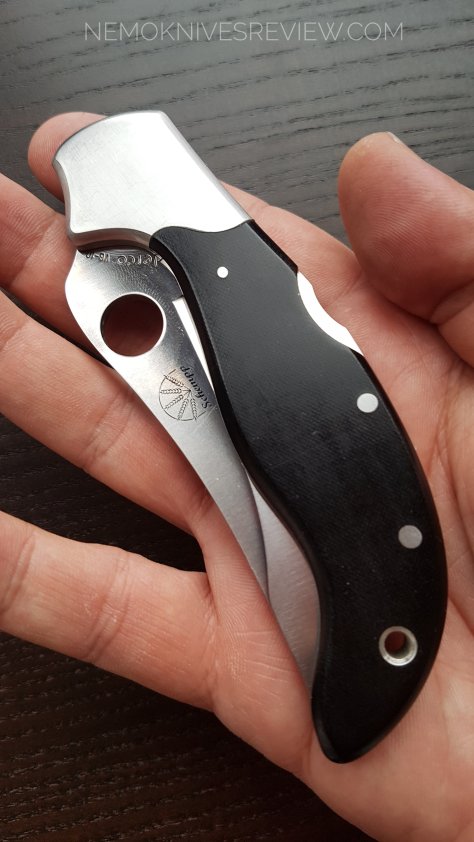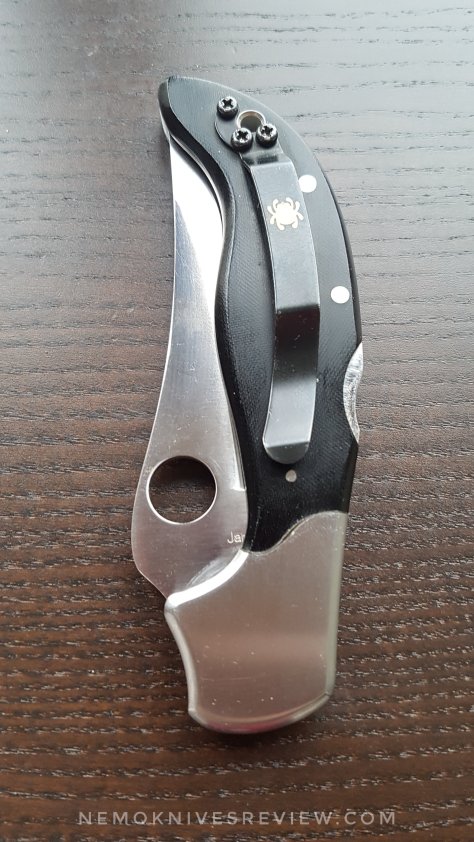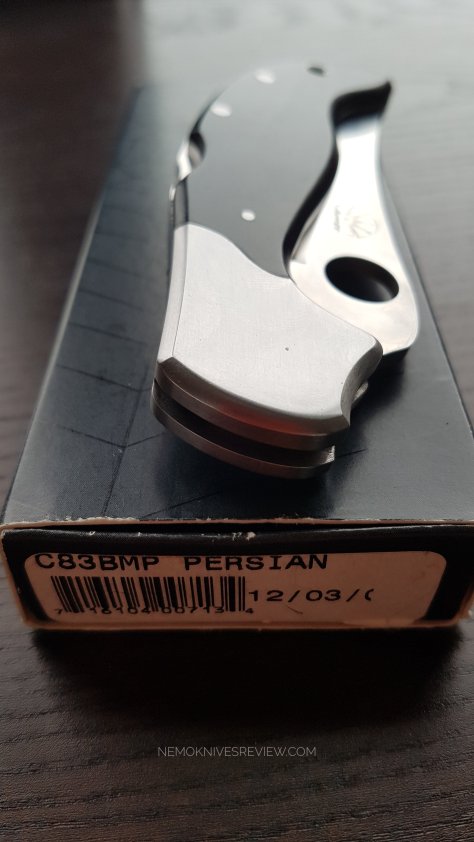
Following my first glimpse on a the Yojimbo Special Run of 2015 , I present you today the classic version of the Yojimbo: G10 handle and S30V steel. There is no difference between the knives but 4 grammes in favor of the CF version (110 vs 115).


The blade got the exact same length (on the photography, the Yo2 on the right is resting on her clip hence the parallax…). I have also found the detent to be harder on the S90V run but who minds ?
Now the main difference is the steel: S30V vs S90V.
Quoting Jerry Hossom on the knifenetwork.com :
“S90V contains 9% Vanadium. S30V contains 4% Vanadium (originally it was planned for 3% and thus the name). Vanadium carbides are VERY hard and provide a lot of wear resistance. On the flip side of that S30V was designed to be very tough; it resists chipping and breaking. S90V was designed to be very wear resistant, so it’s really a tradeoff. If you’re very careful with your knives, don’t toss them in the sink or hammer them through hard beef bones, S90V will do very well. If you’re rough on a knife, S30V will be a better choice. I’d likely choose S30V for larger knives, because they’re subjected to greater stresses. S90V is certainly fine for smaller knives. ”

So how S90V will behave on EDC chores with the Yojimbo blade particular shape especially its very narrow point. I remember the same kind of exchanges on the forums about the point of the CPM 440V (S60V)C36 military and our request to see a Millie with some strong tool steel hence the desire for CPM M4, CPM3V and CPM Cruwear version.

Back in 2002 I got the chance to own a Ronin made in VG10. The Ronin was a Mike Janich and Mike Snody collaboration on a SD fixed blade and more precisely a neck knife. I used mine for every day chore until the tip get broken and I was obliged to regrind it.

Here is my 15 year old Ronin next to the Yojimbo.
What I love in this design was the way It would cut on hard material without compromise the edge: only the point was touching the plate for example.
Then as S90V is known for its wear resistance, I should be able to keep the point sharp for a longer time…. And time will tell.

Some words from Mike Janich taken from the Spyderco Forums:
“Hey, Guys:
Thank you all for your comments and enthusiasm regarding the Yo2. I am very pleased to have it in production and I’m thrilled at the way it turned out.
I wanted to share a couple of fine points regarding the design. Like everything else I do, I like to explain why. You are free to agree or disagree, like or not like, but at least you’ll have the information to make a decision.
With regard to the not-fully-exposed Spyderco hole, I wrestled with various options on this during the design. I did not want to do the large index-finger choil of the original Yo because it narrows the grip too much in that area and starts to force the hand into a saber grip. The goal was to keep the closed knife as narrow as possible to preserve access to the pocket.
I had a similar challenge when I designed the Be-Wharned. One thing that I learned during that process was that the natural hand position for a thumb opening is typically not with the plane of the handle completely flat. Most people naturally hold the knife palm up, but with the knuckles at about a 45-60-degree angle to vertical. That means that your thumb also indexes the hole (or stud) at an angle, not flat on top of it. With the Be-Wharned, holding the knife at this natural angle and driving the thumb straight along the chamfer of the handle produces the most positive, reliable, and comfortable opening.
With that experience as a guide, I focused on the functional part of the Spyderco hole. When the closed knife is viewed with the edge down, tip to the left, this section is from 12 to 3 o’clock. That’s where the thumb actually bites and drives. That part of the hole is completely unobstructed.
As for the lock release cutout, I purposely made it smaller than that of the Para2. There are two reasons for this: First, some users–especially those who grip the handle tightly with their index fingers during opening–get a slight pinch from Compression Locks as the blade is opened. This is caused by the liner moving into the G-10 scale as the blade clears the detent ball. To mitigate this effect, I asked that the top of the Compression Lock tab be recessed slightly below the top edge of the G-10 scale and purposely made the recess smaller.
Second, speed closing of the knife is not high on my priority list. I close the knife by pinching the lock between my thumb (on the G-10 scale) and the nail of my index finger (on the lock tab). I can do this (and have done it) all day long without soreness or fatigue. For me, it’s perfect the way it is. Most importantly, the knife closes exactly when I want it to and I still enjoy both the extreme strength and the I-don’t-need-to-put-my-fingers-in-the-path-of-the-edge safety of one-handed closing.
I chose the standard hourglass clip for the Yo2 because it has been refined and perfected over the years. It works great, so why reinvent the wheel? Also, savvy Spyderco fans know that the same basic clip design used on the Yo2 is used on the Endura and Delica, but in black (and with the addition of the lanyard hole that matches the holes in those knives). Don’t like the shiny clip on the Yo2? Buy a replacement clip for an Endura for a few bucks and you’ve got an instant subdued clip. How easy is that?
As far as clip position goes, most folks know I prefer tip-up carry. The key to getting a personal defense knife into action quickly is being able to draw it and immediately open it without having to change grip position. The key to that is making sure that the overall size of the closed knife, the position of the Spyderco hole, and the height of carry are all proportionate to the average hand size. If you have a big knife with a deep-pocket clip, it may carry discreetly, but when you draw it, you’re holding it by the butt end with your thumb a long way from the hole. Unless you can magically Viagra your thumb into growing, you have to change your grip to get the knife open.
The clip placement on the Yo2 makes the knife ride high enough so that, with a proper draw, your thumb is automatically on the opening hole when the knife clears the pocket.
If you prefer discretion and a low profile over deployment speed, I purposely added tip-down carry to the Yo2. The clip holes at the pivot-pin end of the handle are as close to the front edge of the handle as physically possible to support deep-pocket carry. Yes, it’s tip down, which is slower. So is deep pocket carry in general. If you need deep-pocket carry and speed, arry tip down and use a Spyder-Drop opening. You’ll find that although a small portion of the Spyder Hole is obscured, there’s still plenty of surface area to grab onto. As you pinch the hole with your thumb and index finger, you’ll also find that your fingertips start to push the handle away from the blade, “cheating” your start on the opening.
As for a lanyard hole, I’m not a fan of fobs, so I opted for the additional strength of a screw post at the butt instead of a lanyard tube. However, if you are a lanyard fan, there is still enough room between the blade edge and the screw post to wrap a thin lanyard around the post with a cow hitch. That keeps the lanyard centered in the handle instead of wrapping around it and makes for a sleeker package. Think of a typical flashlight lanyard where the loop that attaches to the light is thin and strong and the rest of it is 550 cord sized. If you must use 550 cord for the whole lanyard, pull the guts out of it so it wraps flat around the screw post.
I hope this helps you better understand why the Yo2 is the way it is. A lot of thought went into it and it is truly a reflection of more than 35 years of experience, training, and daily carry of personal defense knives.
Stay safe,
Mike
P.S. As far as meat cutting tests go, yes, that was a big part of my personal R&D of the prototypes. Simple answer: It has more blade length than the original Yojimbo. It therefore cuts even deeper.”

Another one from Michael Janich in August 2012:
“Thanks for the discussion and your continued enthusiasm for the Yo2.
When I designed the blade for the Yo2, I took a lot of inspiration from the Manix2, both because I like the way it cuts and because, as a Golden-made product, its manufacture respresented a known core competency for Spyderco. Combining a partial hollow grind with a thick, strong spine provides a great balance of edge geometry and strength. Moving the point up towards the blade’s centerline moves it toward the thicker part of the blade; however, if the hollow grind runs parallel to the edge all the way to the point, the resulting point thickness is functionally the same as what you get with a wharncliffe.
The wharncliffe blade excels at cutting because it cuts with full power all the way to the tip. An acutely angled tip also provides superior penetration with minimal effort.
From a utility standpoint, the Yo2’s tip is analogous to an X-Acto knife and is excellent for detail work. The heel of the blade, closer to the handle, is extremely strong and more than capable of tackling most cutting chores for which knives are appropriate tools. In general, if you focus on using the part of the blade that is most appropriate to the task at hand, you can perform a wide range of cutting chores without a problem.
Having designed several wharncliffe blades now, I have also been privy to the warranty repair claims concerning these blades. In all honesty, broken tips are rare. The ones that do come in typically come with a story that begins “I dropped my knife on concrete/a hard tile floor….” or “I know I shouldn’t pry with a knife, but…”
Like a box cutter, a wharncliffe cuts with both power and finesse because of its straight edge. If your style of utility knife use actually focuses on cutting, it will serve you well. If your utility knife use focuses on prying, digging, or using your knife as a jack handle, buy a knife that is better suited to that type of use–and don’t expect it to cut very well…
I hope this helps.
Stay safe,
Mike
Michael Janich
Spyderco Special Projects Coordinator
Founder and Lead Instructor, Martial Blade Concepts”




























